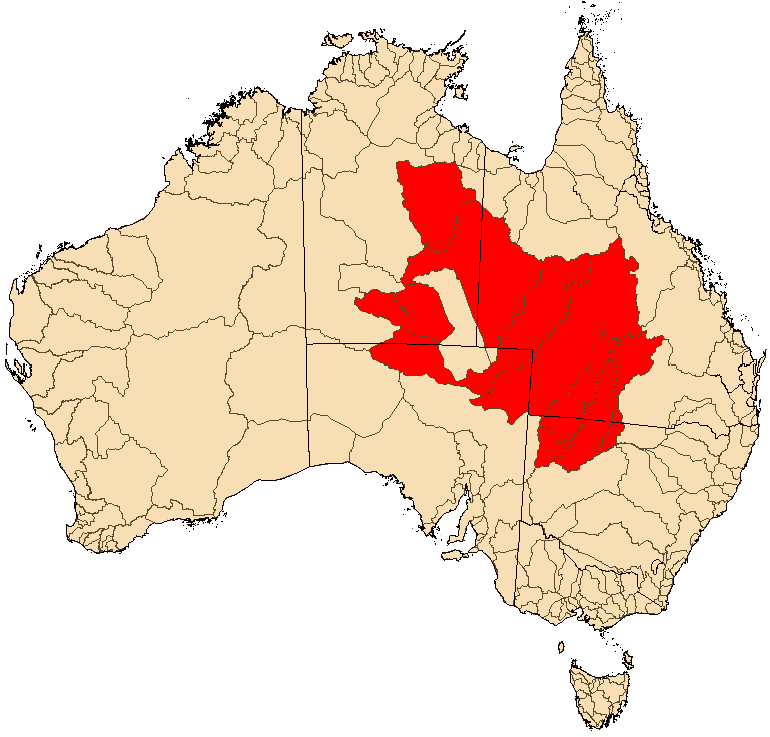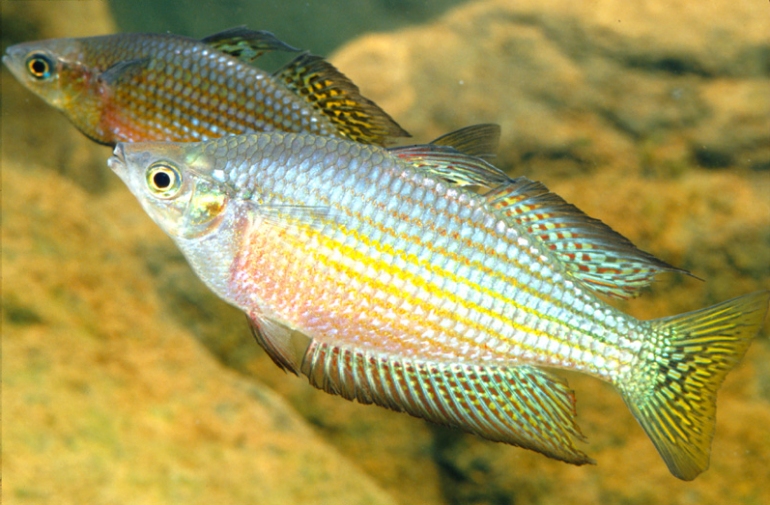|
 GS.jpg) |
Melanotaenia splendida tatei (Ellery Creek) - photo© Gunther Schmida |
(Zietz, 1896)
Desert Rainbowfish
Species Summary
Melanotaenia splendida subsp. tatei was originally named Nematocentris tatei by Zietz in 1896 after Ralph Tate (1840-1901), a geologist and botanist who was on the 1894 Horn Expedition when this species was first collected. Melanotaenia s. tatei is a small, laterally compressed fish. They may reach a maximum size of 10 cm, but usually less than 8 cm SL. The eyes are large and positioned towards the top of the head, and the mouth is moderately large, oblique and upturned. There are two dorsal fins separated by a small gap, with the first short-based and the second long-based. There is a long-based anal fin and the tail is moderately forked. Two colour forms exist; in one form males have a purple body with yellow-green fins, with dark flecks and a dark border. The other form has a blue-green body with similar colouration on their fins. During spawning the belly of the male turns bright pink. Colour varies depending upon the mood of the fish, water conditions and diet. Females and juveniles have plain silvery bodies with clear fins. Males are usually more brightly coloured with pale stripes along the sides, larger, and much deeper bodied than females.
 |
Distribution Map |
Distribution & Habitat
Melanotaenia s. tatei is widespread and abundant in the larger rivers of the Lake Eyre Basin and the Western Plateau of the Northern Territory. This species has only recently been identified from the Murray-Darling Basin, where it is recorded from the arid rivers in the north-western basin. It is found only in the Paroo and Warrego rivers, and hybrids with Murray-Darling rainbowfish have been identified in the lowermost Warrego River and the Darling River from around the Bogan River down to at least Menindee. Any rainbowfish captured in or near the Darling River need to be carefully examined, as confusion or hybridisation with Murray-Darling rainbowfish is likely (P.J. Unmack pers. comm.).
Melanotaenia s. tatei inhabit semi-permanent streams, springs, artesian bores (wells), and lagoons. During prolonged droughts, the fish are confined to isolated pools. Their natural environment is subjected to seasonal variations with water temperatures ranging between 24°C during the dry season and up to 33°C in the wet season. The water is generally alkaline (pH 7.2-8.0); however, they are occasionally found in acidic conditions (pH 6.5-6.9). They are usually found around sub-surface vegetation, submerged logs, or branches. Living in a hot and arid environment Melanotaenia s. tatei has broad physiological tolerances.
 |
Melanotaenia splendida tatei (Finke River) - photo© Gunther Schmida |
Biology & Ecology
Little is known of their biology or ecology, but they have broad physiological tolerances. Strong sexual dimorphism is present in the species with males typically being larger and brighter in colouration. During spawning the ventral region of the male turns bright pink. Spawning typically takes place during the warmer months when temperatures are above 20°C, or whenever ample rain falls. Females produce between 100 and 200 small eggs (0.8-0.95 mm diameter), spawning a number of times daily for several days. Eggs adhere to water plants and hatching occurs after 6-7 days. The newly hatched larvae are around 4-5 mm long. Spawning more commonly occurs in the morning with eggs being scattered over vegetation or aquatic debris. They probably mature within a few months at around 30-50 mm.
Balcombe et al., 2005 found that terrestrial fauna was a major food group consumed by Melanotaenia s. tatei. Their diet consisted of terrestrial insects (67.4%), other terrestrial invertebrates (10.2%), algae (16.8%), and aquatic insects (5.6%). In addition to the consumption of some aquatic insects and algae, this species fed chiefly upon terrestrial arthropods, many of which were flying insects (e.g., ants, wasps and dipterans). Other items included aquatic dipterans, coleopteran larvae and zooplankton. The aquatic dipterans were mostly chironomid larvae, while the zooplankton prey consisted chiefly of conchostracans and cladocerans. Terrestrial foods included isopods, scolopendridid centipedes, or a variety of alighting insects such as dipterans, hymenopterans and coleopterans. Up to 100% terrestrial insects was consumed during the dry season.
Literature
Balcombe S.R., S.E. Bunn, F.J. Mckenzie -Smith and P.M. Davies (2005) Variability of fish diets between dry and flood periods in an arid zone floodplain river. Journal of Fish Biology, 67: 1552-1567.
Duguid A., J. Barnetson, B. Clifford, C. Pavey, D. Albrecht, J. Risler and M. McNellie (2002). Wetlands in the arid Northern Territory. A report to Environment Australia on the inventory and significance of wetlands in the arid NT. Parks and Wildlife Commission of the Northern Territory.
Unmack P.J. (1995). Desert fishes down under. Proceedings of the Desert Fishes Council 1994, 26: 71-95.
Unmack P.J. (2001). Biogeography of Australian freshwater fishes, Journal of Biogeography, 28, 1053-1089.
Wager R. & P.J. Unmack (2000). Fishes of the Lake Eyre Catchment of Central Australia. Queensland Department of Primary Industries, Brisbane. 90pp.
Zietz A.H.C. (1896). Pisces. Report on the work of the Horn Expedition to Central Australia. Part 2. Zoology. Horn Expedition: 176-180, Appendix, pp. 410-411, Pl. 16.
Adrian R. Tappin
Updated May, 2013



|
|

